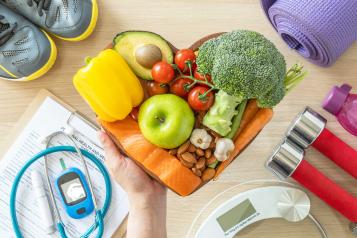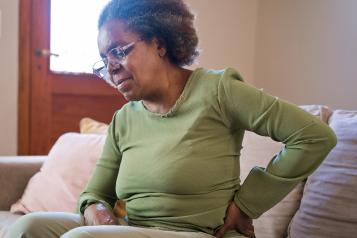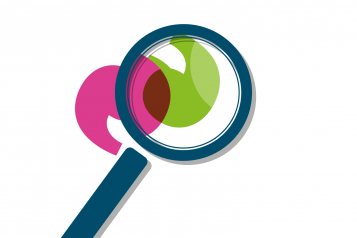Questions and answers on high blood pressure (hypertension)
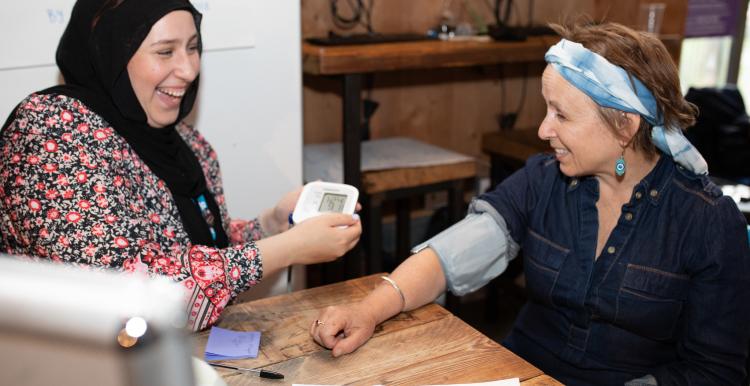
Measuring your blood pressure
When you have your blood pressure measured, the reading is given as two numbers. For example, your reading might be 120/80 mmHg* and you'll be told something like '120 over 80'.
- The first number is the highest level of your blood pressure. It's the pressure when your heart beats and contracts to pump blood through your arteries. This is known as systolic pressure.
- The second number is the lowest level of your blood pressure. It's the pressure when your heart relaxes between beats. This is known as diastolic pressure.
*mmHg is a unit for measuring blood pressure and it is short for millimetres of mercury.
These training sessions were requested by our partners and the residents they support. The questions the participants put to the experts during the workshops are reproduced here. The content has been checked for accuracy by those same experts before publication.
What are the readings displayed on a blood pressure monitor?
The readings displayed on a blood pressure monitor are the systolic pressure (upper number) and diastolic pressure (lower number), and the pulse rate.
The pulse rate shows the number of heartbeats per minute (bpm), which indicates how fast your heart is beating during the measurement. A regular pulse rate for most adults at rest typically falls between 60 and 100 beats per minute (bpm).
What are the symptoms of high blood pressure?
High blood pressure typically has no noticeable symptoms. Rarely, high blood pressure can cause symptoms such as headaches, blurred vision, or chest pain. The only way to find out if you have high blood pressure is to get your blood pressure checked.
Why are the numbers for a high blood pressure reading defined differently at a doctor’s compared to at home?
This is known as "white coat syndrome" or "white coat hypertension". It happens when people feel anxious or nervous in a medical setting, such as at the GP's office. This stress can temporarily raise your blood pressure. That’s why in a medical setting; health professionals will allow for a slightly higher blood pressure reading.
Since the environment at home is typically more relaxed and familiar, your blood pressure readings there are often lower and more accurate. That's why it's important to monitor your blood pressure regularly at home for a true reflection of your usual levels.
Different monitors are sold at the chemist and used by the GP. Which ones are more accurate?
GPs typically use professional-grade blood pressure monitors, which are usually more accurate than the over-the-counter ones sold at chemists. Arm-cuff monitors are generally more accurate than wrist or finger monitors.
If you want to monitor your blood pressure at home, the most important thing is to choose a home monitor which gives you accurate results and is easy to use. It should be clinically validated; automatic (digital) with an upper arm cuff; and within your budget – you don’t need to choose an expensive machine.
Automatic blood pressure monitors need to be re-calibrated at least once every two years.
Where can I get my blood pressure checked?
Some pharmacies offer free blood pressure checks as an NHS service. You can find one near you here: Find a pharmacy that offers free blood pressure checks - NHS. You may be able to get your blood pressure checked in your local GP waiting room or at community events. You could also check with your local GP, as they might loan you a monitor to take home.
You can purchase blood pressure monitors for home use from any local pharmacy or online. The British Heart Foundation has advice for buying the right kind of blood pressure monitor and how to check your blood pressure properly.
What is more accurate to measure blood pressure: arms or legs?
Measuring blood pressure in the arm is typically more accurate than in the leg. The arms are closer to the heart, so readings are more reflective of central blood pressure.
Do you know how I can reduce my blood pressure? If not at high risk, I am getting close.
Maintain a healthy lifestyle. Regular physical activity, reducing salt intake, limiting alcohol, avoiding smoking, and eating a balanced diet can help lower blood pressure. Eating a healthy, balanced diet that is low in salt can look like:
- Eating at least 5 portions of fruit and vegetables every day.
- Eating lean protein like chicken, turkey, fish, eggs, or beans. Try to eat fish at least twice a week, including one portion of oily fish.
- Choosing wholegrain varieties of carbohydrates.
- Eating lower fat and sugar-free dairy products.
- Avoiding sugar and fat to maintain a healthy weight, and especially saturated fat.
- Eating a diet rich in potassium. Eating a range of foods that are high in potassium, especially fruit and vegetables, helps to lower your blood pressure.
- Aim to eat less than 6g of salt per day. Try to cut down on high-salt foods. Cooking sauces, table sauces such as ketchup and mustard, cheese, bacon, olives, and pickles can contain a lot of salt. Curry powders and pre-mixed spices can have added salt too.
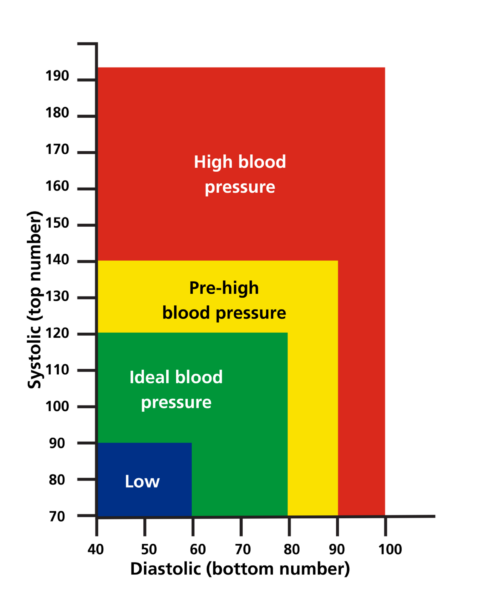
Diagram showing blood pressure ranges
Do I check my blood pressure every day or every week?
If you have high blood pressure, it's a good idea to check it daily to monitor any changes. If it’s well-controlled, weekly checks may be enough. Always consult with your doctor, as they will create a plan with you to help manage your blood pressure.
What level is best for blood pressure, and can you show me what is high?
The normal range for blood pressure is around 90 to 120 mmHg for the upper number (systolic pressure) and 60 to 80 mmHg for the lower number (diastolic pressure). For the average adult, an ideal blood pressure is around 120/80 mmHg. This might be different based on your personal circumstances.
Under 80 years old, a normal blood pressure looks like:
- Lower than 140/90 when checked by a healthcare professional
- Lower than 135/85 when checked at home
Over 80 years old, a normal blood pressure looks like:
- Lower than 150/90 when checked by a healthcare professional
- Lower than 145/85 when checked at home
Where can we find free or low-cost exercise activities?
There are over 500 activities on offer in Islington, ranging from archery, badminton and cycling to walking, yoga and Zumba. These are at more than 100 clubs, leisure centres, parks, schools, libraries, community centres and other venues. Many are free or low-cost, and many are focused on specific groups – women & girls, people with a disability, age 50+, young people, LGBTQ+. There is something for everyone, whatever your physical ability, age, or whether you have a disability.
For more information on high blood pressure, visit www.bloodpressureuk.org.
